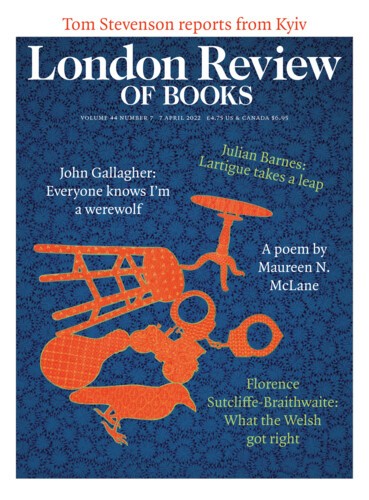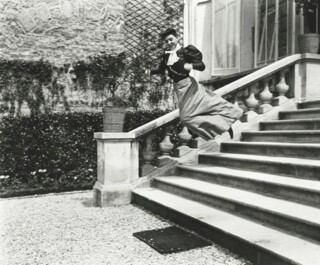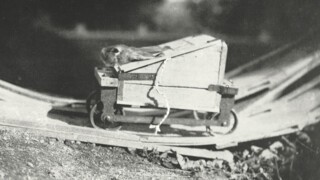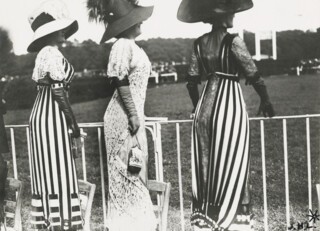When the Italian theorist Ricciotto Canudo pronounced cinema the ‘seventh art’ in 1911, photography had the right to sulk: after all, what was this arriviste form but a succession of photographs made to move? Photography had not received such commendation in the sixty years of its existence. But like jazz, it was an art that seemed to arrive fully formed and any such formal consecration might probably have been as bad for 20th-century photography as it would have been for jazz. It was a democratic and portable art – increasingly so as shutter speeds got faster – often bringing out the fun in its participants. I have a larky postcard shot of Puccini and a friend with their heads poking from beneath the rollers of a mangle, while one of them pretends to turn the handle. They wouldn’t have posed like that for a portrait painter.
In a film for the BBC in 1983, when he was in his late eighties, Jacques Lartigue was keen to stress the most fortuitous aspects of his career. ‘There was a fairy over my cradle,’ he said. He claimed that he never ran after a photograph; the photograph always came to him. He rarely needed more than three or four shots, and almost always worked with natural light. Nor did he feel any obligation, as others might have done, to erect a few principles or theories about his art. Asked how he found the ‘decisive moment’, the catchphrase always associated with Cartier-Bresson (though first used in the 17th century by the Cardinal de Retz), he replied: ‘You do it before you have time to think.’ There was no technical secret at all. ‘I used to be a tennis player, so I have a very fast eye.’ When congratulated on the composition of a particular fashion shot – a model walking towards him on a black and white marble floor in Versailles while a colonnade recedes behind her – he shrugged aside the compliment: ‘No, it was just there.’ ‘It’ being the shot, coming amicably towards him. He had, he claimed, remained ‘an incorrigible little boy’. His attitude to life was blithe and approving: ‘To me, whatever happens is all right … All times can be happy, and all places can be beautiful.’ It is a disarming display of smiling Gallic crackerbarrel.
But it would also be easy to take him at his word. That fairy over his cradle may have brought him a fast eye, but his family gave him the means to exploit it. His father, Henri, owned the eighth biggest fortune in France, and the family lived in a grand and mobile fashion: summer at Deauville and the Channel resorts; winter on the Côte d’Azur; autumn at a country château, first in Normandy, later at Rouzat in the Auvergne. Henri was an atypical bourgeois. ‘I have quite enough money,’ he said. ‘My children should learn how to spend it, not earn it.’ He declined to send either Jacques or his brother, Maurice, known familiarly as Zissou, to school. Instead, they were provided with indulgent tutors. The famous first line of Jacques’s diary runs: ‘The world for me is like an immense parkland.’
Technical invention ran in the family: Henri’s father had invented a monorail for transporting esparto grass across the Algerian desert; his uncle created an ‘automatic train whistle’ for the railways. Henri himself was a skilled amateur photographer who taught Jacques all he knew, before turning his attention from still to moving pictures. He had a passion for new inventions – hot air balloons and scooters and electric cars (one of which he bought in 1902) – but also the really fast and noisy stuff: racing cars and aeroplanes. This Lartigue gene was mainly inherited by Maurice, who built gliders and aeroplanes with the help of the domestic staff and then flew them. He also constructed a loop-the-loop machine with a wooden track running down from the second floor of the Auvergne château to ground level, where the speed attained threw its cargo up round a ten-foot-high loop. The ‘passengers’, stuck inside a wheeled wooden box, were rabbits and chickens, and the idea was to demonstrate centripetal force; before and after each trip the animals’ eyes were examined to see if the experience had produced greater dilation. Zissou was the engineer and ideas man, Jacques the observer and recorder. The elder brother quickly turned into a young dandy. One of the funniest photos Lartigue ever took was of Zissou in the boating pool at Rouzat in 1911. Zissou is sitting in a ‘rubber pocket’, a recent invention (not his) for duck hunters. It consists of a fat inner tube onto which are moulded a pair of rubber legs, dimly present below the surface of the water. Above it, the visible and sharply focused top half of Zissou: a three-piece suit, a tie with tie-pin, a dangling hand flashing a signet ring, an expressionless adolescent face, neat moustache, dark glasses and a kind of rustic solar topee. He gazes at the camera as if daring us to deny he is the epitome of cool.
Jacques was given his first – heavy wooden, plate – camera at the age of eight. He was a quick learner whose passion gained parental respect: in 1904 he received a Gaumont Block-Notes with a shutter speed of 1/100th of a second, in 1910 a Klapp-Takyr with a speed of 1/1000th of a second. His mother allowed him to take his camera to Mass every Sunday, so that afterwards he could return straight to his hobby. He photographed what he knew best, the ‘immense parkland’ that lay around him and which he imagined to be normal life: the family and their servants; and the leisured and fashionable at their pleasures, on the beach, at racecourses and ad hoc aerodromes, on skis and skates and bobsleighs. He stood close as racing cars roared past, learning to do a quick pivot to enhance the impression of speed. He also stood as close as he could to the glamorous, brilliantly dressed women – some respectable, some less so – who came towards him at a somewhat lesser speed in the Bois de Boulogne. The park had three main walks: one for cars, one for riders, and a narrow pedestrian way between the trees with the winning name of the Sentier de la Vertu.
This is where I lie in wait, sitting on an iron chair, camera controls fine-adjusted. Distance: four to five metres; speed: shutter screen slit 4mm; aperture: depending on which direction she arrives from. I’m very good at roughly guessing the distance. What’s less easy is if she has just one foot forward at the moment of correct focus (this is what is the most amusing to calculate) … She is the lady in all her get-up, very fashionable, very ridiculous … or very pretty, who knows? Far off, among the walkers, she stands out like a golden pheasant in a henhouse. She approaches … I’m shy, trembling a little. Twenty metres … ten metres … eight … six, and click! The shutter of my big camera makes so much noise that the lady jumps almost as much as I do. It doesn’t matter a bit, except to the man with a loud voice accompanying her who, with a furious look, starts to get hold of me. On the outside, I smile, but inside, on some days, I’m quaking in my boots. What does it matter, though, all that counts is the pleasure of having a new photo.
And so some of the most stylish and echoing photographs of the Belle Époque were taken: of the galleonic Anna la Pradvina being towed along by a pair of Jack Russells; of women in towering rococo hats and complicated veils; of a threesome (two in black-and-white striped dresses) standing on chairs at a racecourse – an image which half a century later inspired Cecil Beaton in his designs for My Fair Lady. Suspicious women, welcoming women, absurd women, beautiful women. And they would probably have been less surprised by the appearance of a camera than Lartigue makes out: numerous pre-paparazzi were also lurking in those trees, taking pictures for La Mode pratique and Femina. Few would have looked like the 15-year-old Jacques, of course.
He moved easily in a world where style overlapped with culture: the family’s first country house, in Normandy, had been bought from the composer Massenet; one of his cousins was another composer, Jacques Ibert. And who is that sitting casually on the beach at Étretat in 1907? Debussy and his mistress. One of Jacques’s tutors was the playwright Jean Giraudoux. He took this as normal, though he was never an intellectual, or even much of a reader. His Bois photographs were sometimes likened to Proust, and he happily endorsed the comparison; though he only knew of À la recherche late in life when his third wife read aloud to him from Un amour de Swann. He told Le Monde in 1985: ‘I would, of course, have been delighted to meet Proust, though I’m not sure a rabbit can talk to a cat.’ In June 1913 his mother took him to a performance of The Rite of Spring conducted by Stravinsky. They each reacted in character. ‘What a cacophony!’ Mme Lartigue complained, while Jacques loved watching the dancers ‘leap up like animals’ and regretted that he couldn’t photograph Nijinsky. But he also made the more interesting observation: ‘The orchestra makes a deafening sound that fills me up, like all the great noises I love: aeroplane engines at Issy-les-Moulineaux, racing cars …’ As for ‘leaping like animals’, long before Philippe Halsman made a trademark of photographing celebrities in low to mid-air (from Marilyn Monroe to the Duke of Windsor, from Nixon to – perhaps surprisingly – François Mauriac), Lartigue was practising the trope. In 1905 he caught Maurice jumping off a wall with an open umbrella as faux-parachute; the same year, more famously, his (female) cousin Bichonnade in mid-leap over a flight of stone steps. Decades later, and self-referentially, Lartigue persuaded Richard Avedon to launch himself upwards, camera in hand, with a curling whip of flash cable snaking about in the air.
The world he took part in and portrayed was one where Zola ran into Colette, where Nana met Gigi. And the names – or rather, the nicknames – are part of its sonic environment. Lartigue is surrounded by them: his brother Zissou; his cat Zizi; his nanny Dudu; his aunt Yéyé; his pals Dédé and Oléo and Rico and Biclo and Toto. His father’s private secretary, who already bore the delightful surname of Folletête, as if denying nominative determinism, was rechristened Plitt; he had a Jack Russell called Tupy. Then there were Lartigue’s first two wives, Bibi and Coco, not to be confused with Coco and Chichi, who were the two Jack Russells being walked by Anna la Pradvina in the Bois de Boulogne. And that’s without mentioning Bibi’s friends Lolo and Loulou and Doudou. Jacques’s nickname, among many others, was Pic.
Then the war came. But not really for Jacques and Zissou, who were both judged too frail for front-line duty; instead, Jacques placed himself and his car, a Pic-Pic 16 HP, at the service of military doctors in the Paris hospitals. And as he recorded in one of his multi-volume photo diaries: ‘1915 Année de Guerre: Peu de Photos’. Afterwards, the Belle Époque continued for Lartigue, but with shorter hair, shorter skirts, more beach nudity and some female liberation: he took a suite of photographs called ‘Women with Cigarettes’. Some of his photographs of women – especially of his third wife, Florette – look forward to the fashion shots he took in later years: svelte flesh imprinted by blood-red talons, glittering jewellery, sleek hair. One of the remarkable things in Lartigue’s images is that nothing bad ever happens. A homemade go-kart crashes and bends a tyre out of shape, but no bones are broken; in 1913 his cousin Simone Roussel comes off a scooter on a downhill bend in a blur of black stockings and white petticoats – laughing as she falls. Everyone displays good humour: here is Suzanne Lenglen in 1915, training on a court in Nice in the most stylish of sailor suits; off the ground as she bends and strains for a low forehand volley, she still has time to smile.
The interwar years for Lartigue comprised what the curator Quentin Bajac called ‘a time of refusal of history’. But what else would you expect? As he wrote in 1938, ‘does hiding one’s head in the sand like an ostrich mean being happy? Yes! Then let’s hide our heads in the sand.’ Happiness must be made to continue. Lartigue married three times, the last, to Florette, in 1930. In her excellent account of Lartigue’s early life, Louise Baring summarises his emotional stance: ‘Though he would fall in love often enough, Lartigue in fact had little time for sentiment, preferring, as always, to keep himself barricaded against too much feeling.’ He became a socialite, a painter, an interior decorator and designer. He had a short career as a professional photographer in the mid-1920s, but the commissions fizzled out. As a painter, he showed at the Salons and made something of a name for himself, trying on various styles, none of them very convincing: sub-Van Dongen easing towards Bernard Buffet; then, later, abstraction. In the 1950s he hung out with Picasso and Cocteau (which photographers didn’t?) and alongside some snaps of Picasso in his trademark pose of bare-chested bravado, Lartigue took a wonderful shot of the back of his left calf with acupuncture needles glittering from the flesh. His photographs of sunlit beach and pool, tennis court and café dansant, continued, and continued to remain private. Some of those boyhood photos were occasionally reprinted but largely they were forgotten.
And then came one of the oddest and most complicated of volte-faces. In 1962 Lartigue went to America and showed two of his early albums to Charles Rado, founder of the Rapho Agency. He passed them on to John Szarkowski, newly installed as photography curator at MoMA, who in 1963 put on what was only his third exhibition, devoted to 46 of Lartigue’s Belle Époque photographs. Lartigue was 69 when it opened. ‘Le tout New York is talking about … my little photos’ – except that some of them were now considerably enlarged, and repackaged, with white frames against white walls, as a ‘sleek modernist oeuvre’. A photography show in a major museum needed a backstory, if not a theory. MoMA proposed that such ‘radical’ work ‘could have been achieved only by a true primitive’. Lartigue was a ‘precursor’ to Cartier-Bresson, a missing link in the history of photography, but also useful evidence against the dominant contemporary aesthetic theories such as Greenbergian formalism. As Kevin Moore put it, ‘Szarkowski attempted to show that expressive pictures resulted from ingenuous immersion in real life rather than from art training or the editors of picture magazines. For Szarkowski, photography in the hands of amateur practitioners held the greatest potential for isolating the aesthetic values intrinsic to the medium.’ The ‘decisive moment’ of Lartigue’s career had suddenly, belatedly, come. He was an international star, embraced and commissioned by fashion glossies, invited to take the official presidential photograph of Giscard d’Estaing. He even had his first major show in France, though not until 1975, rather a shameful twelve years after MoMA. His reputation was secure.
And yet at a strange cost. His childhood and teenage selves had re-emerged to wipe out all that his adult selves thought they had achieved. How could this not provoke some trauma? Yet all Lartigue would admit to was being ‘lightheartedly’ displeased that his painting was not so well liked as his photographs. If you look up art websites today, the photographs – even in much later reprint form – sell for up to 16,000 euros, while original paintings go for a few hundred.
His post-rediscovery work is always competent, if somehow characterless. Magazines, wowed by his late fame and longevity, persuaded him to return to his own tropes. He goes back to the Bois de Boulogne and photographs a pretty model in what looks like Courrèges towing a poodle. It is an anodyne imitation. Another idea: where are the latest fashions currently to be found? In ‘swinging London’, of course. So off Lartigue sets to capture girls in hot pants next to men in bowler hats; but none of those images is a tenth as striking as the ones he took of his wife Bibi sitting alone on the top of an open-deck London bus in 1926.
In the long period between childhood brilliance and MoMA apotheosis, Lartigue came up with some brilliant images, such as the 1951 shot of soldiers’ boots and gaiters peeping from beneath the bottom of a vespasienne. In 1957 he went to Lourdes and returned with a colour shot of a procession of hopeful pilgrims in small hooded wheelchairs being pulled along effortfully by stern-faced nurses. Lartigue is standing close to their route, as he had done when photographing racing cars and fashionable women. But that echo doesn’t distract from what is a serious image of life and death and spiritual hopefulness. The lead supplicant firmly grips the handbag on her knees and ignores the rude photographer, as does the nurse. The picture is neither frivolous nor satirical. Lartigue was a lifelong Catholic: as a child he had knelt before the crucifix on his bedroom wall, asking God to help improve his photography. He took his first Holy Communion in Paris in 1907. ‘He often spoke of the ceremony,’ Florette recalled, ‘which made a deep impression on him … His lifelong faith never wavered.’
Perhaps God helped Lartigue to live in his own bubble during his supremely long career. At the start of it he overlapped with Atget, who was photographing dilapidated buildings in empty streets while the young Lartigue lay in wait for his ‘golden pheasants’ on the Sentier de la Vertu. (Strangely, in 1899 Atget had photographed a crowd of children watching a puppet show in the Jardin du Luxembourg – and there, in the third row, standing up admiringly, is little Jacques.) At the other end of his career Lartigue knew Avedon, Hiro, Ansel Adams, Helmut Newton and Willy Ronis. And yet – the bubble again – he appears never to have commented on other photographers’ work.
Many decades earlier, the prospect of leaving behind his idyllic childhood had dismayed him: ‘Sometimes I find myself full of sorrow because I’m growing up. I would like to be able to stay as I am … I often cried because I was growing up … this happiness won’t last forever.’ But he went on insisting that it had and did, through all his turns of fortune, into old age and before the BBC cameras. Geniality in an artist, especially an old one, should be treated with suspicion. How disingenuous was he? And for how long? Lartigue’s son Dani, interviewed in 2003, said: ‘For my father, happiness was a constant battle. To overcome his chronic anxiety, he needed to prove to himself, through his indelible images, that this happiness buried deep inside of him was his raison d’être.’ This seems convincing: chronic anxiety is the more usual condition for any artist and a more reliable prompt to originality. The condition his son identified shows briefly in that BBC film when Lartigue declares that ‘photography is a lighter game; painting is a profound one.’ The paradox, or truth, of the declaration being that he was a very light painter but a profound photographer. And in the end – by which time it mattered little – photography was finally promoted to being either the eighth or the ninth art, depending on your Wikipedia choice. In some lists it loses out to comics.
Send Letters To:
The Editor
London Review of Books,
28 Little Russell Street
London, WC1A 2HN
letters@lrb.co.uk
Please include name, address, and a telephone number.




